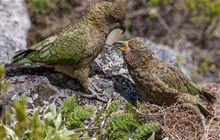Kea monitoring
Introduction
Kea nesting improves after 1080 treatment.The endangered kea is one of the most intelligent birds in the world. Kea will explore novel objects and scavenge for human food given the opportunity. But this can be their downfall when birds interfere with traps and poison bait meant to protect them.
DOC scientists have monitored kea after 1080 operations for a number of years. This has allowed us to weigh up benefits of pest control with the risk that 1080 will kill some birds.
Overall, monitoring shows that when predators are controlled with well-timed aerial 1080 treatment and/or traps, about 70% of kea nests are successful, ie produce at least one chick.
Without pest control, typically about 60% of kea nests fail – mostly due to being preyed on by stoats or possums, and in some areas, feral cats.
But, nest failure climbs to more than 90% in a stoat plague, the year after beech or rimu forest seeding. Only about 10% of nests are successful in these years.
Without pest control kea will continue to decline.
How many kea deaths by 1080 is too many? Read an article on The Spinoff about the challenge of balancing pest control with conservation.
Studying the benefits of pest control for kea
DOC scientists have published research in the NZ Journal of Ecology (June 2018) on the effects of aerial 1080 in protecting nesting kea from predators.
This research was carried out from 2009-2012 on the South Island West Coast. It measured the nesting success of kea and compared this before and after aerial 1080 treatment and with an area where there was no predator control.
The results showed that kea nests were nine times more likely to survive and successfully produce chicks after aerial 1080 predator control.
Research also shows there is a risk of losing some kea to 1080 poisoning but in most cases this risk is easily offset by the improved nesting success after predator control.
Our scientists calculate that overall, the kea population is better off after 1080 treatment than without it. If predators are not controlled after a beech mast or seeding event, high stoat levels wipe out most nests and kill adult birds too.
Risk to kea from 1080
Our scientists have analysed the risk that kea will eat toxic 1080 cereal baits. Published research shows that the kea that live close to areas where they can scrounge food from people are at much higher risk of being poisoned than kea in remote areas.
Kea in the remote backcountry, where most of our aerial 1080 predator control work is done, are at low risk of being poisoned and any deaths are easily offset by greater nesting success and more young birds in the population.
Feeding kea and allowing them to scavenge our food is not only bad for their health but puts them at greater risk of dying in our predator control operations.
Research in Kahurangi National Park
DOC has monitored kea nesting success in Kahurangi National Park since 2009.
In the 2015 and 2016 kea breeding seasons, on average 50% of monitored nests produced young kea. This followed aerial 1080 predator control in 2014 and 2016.
This is a big improvement on previous years without predator control in Kahurangi. Between 2009 and 2014 only 2% of nests were successful in areas without predator control.
DOC has tracked a total of 71 kea through 1080 operations in Kahurangi National Park (2009-2016) at four different sites (Mt Arthur, Wangapeka,Anatoki, and Oparara) and two birds were poisoned. The loss of these birds is unfortunate but would have been easily offset by the much better nesting success of the kea population in the park after predator control.





